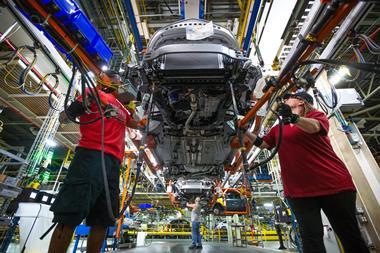GM has restructured its order fulfilment, supply chain and logistics to share more common objectives, grouping them together in a department reporting to James Bovenzi
 The size and complexity of General Motors’ supply chain mean that designing and sourcing the most effective logistics and distribution network for the carmaker is a continuous and ever-changing process. Consider GM’s current footprint: more than 170 assembly, powertrain and component plants in 31 countries; more than 7,700 supplier locations; 20,000 dealers in 140 countries, including 5,000 in North America alone; 900 inbound and outbound logistics providers; and operations supported by another 19,000 indirect suppliers across a variety of services.
The size and complexity of General Motors’ supply chain mean that designing and sourcing the most effective logistics and distribution network for the carmaker is a continuous and ever-changing process. Consider GM’s current footprint: more than 170 assembly, powertrain and component plants in 31 countries; more than 7,700 supplier locations; 20,000 dealers in 140 countries, including 5,000 in North America alone; 900 inbound and outbound logistics providers; and operations supported by another 19,000 indirect suppliers across a variety of services.
In this story...
Having the most effective organisation and partners to manage such networks may also be something of a moment in time. Those steering the supply chain must not only ensure they have the right logistics capacity to meet demand, but that they have sufficient access to the data, IT and market knowledge needed to make well-informed decisions.
Having such tools and skills cannot be taken for granted at a company like GM, where legacy systems and traditional processes can quickly fall behind digital and automated systems, raising the risk of poor communication and forecasting with suppliers and customers.
Budgets, of course, also shape management decisions. The sums of money involved in GM’s sprawling supply chain are, on their own, more than the entire finances of some large companies, and the carmaker spends nearly as much on logistics each year as it does on vehicle development. Rightly or wrongly, it’s hard to imagine many senior OEM executives who wouldn’t want to see that amount reduced, and so pay it more attention.
It is partly for such reasons that GM’s organisation for logistics and supply chain has been a frequent topic of change. In recent years, the carmaker has revised its policies and approaches to material sourcing, supplier relations and contracts, insourcing and outsourcing. A number of strategy iterations have been planned, trialled and sometimes jettisoned.

For the past 18 months, the carmaker has also been in the midst of further important changes in its logistics and supply chain organisation, with James Bovenzi, who took over in December 2014 as executive director of GM’s global purchasing and supply chain organisation (GPSC) in North America, taking the reins of the newly formed demand/supply department.
The objective of the revised structure is to attain a more ‘end-to-end’ perspective in supply chain and logistics, from suppliers through to sales, integrating areas that cover forecasting and analysis on both sales programmes and supplier capacity as well as logistics and materials handling.
Meanwhile, a number of logistics competencies, including sourcing and network engineering, are also being redeployed in-house at GM, often in combination with new or revamped IT systems and analytical tools.
The impacts for GM’s logistics organisation, its suppliers and logistics providers will be significant, as the company aims to become more digitally connected, with automated freight authorisation, invoicing and visibility at every logistics point. GM is also working more in advance of production and launches to develop things like packaging standards and transport strategies, while better understanding potential risk in the supply chain.
[sta_anchor id="1"]“We will have visibility from the moment a part comes off the supplier’s assembly line, all the way through delivering a car to a dealer,” says Bovenzi. “That will allow us to have the right containers, the right packaging, the right mode of transportation, inventory levels and frequency of routes. It’s exciting, what our team is doing.”
The pillars of a new organisation Jim Bovenzi is a 37-year GM veteran who has held leadership roles in regions including the US, China, Germany and Russia, and has had experience across purchasing and supply chain ranging from programme management to supplier localisation. While his current position has a wide scope, one primary objective might be said to define much else: rather than reacting to problems, he wants GM and its supply base to better anticipate economic, consumer and technological shifts that impact plants, suppliers and logistics. To do that, the company needs maximum transparency between departments and with outside partners.
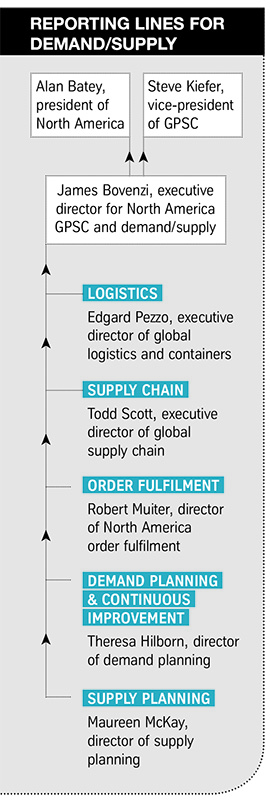 Under Bovenzi, a number of functions have been grouped together that always shared space in the wider GPSC organisation, but whose relation to one another was not always strongly emphasised: order fulfilment, supply chain and logistics. At GM, these areas might be defined broadly as the sales pipeline and customer demand, the material and supply requirements for and within plants, and the transport and packaging that connects all of it (which is also the biggest cost area of the three). In the new structure, these functions retain their own organisations and leaders, but each of them now reports to Bovenzi and they share more common objectives.
Under Bovenzi, a number of functions have been grouped together that always shared space in the wider GPSC organisation, but whose relation to one another was not always strongly emphasised: order fulfilment, supply chain and logistics. At GM, these areas might be defined broadly as the sales pipeline and customer demand, the material and supply requirements for and within plants, and the transport and packaging that connects all of it (which is also the biggest cost area of the three). In the new structure, these functions retain their own organisations and leaders, but each of them now reports to Bovenzi and they share more common objectives.
The separate departments were “very strong pillars of this house”, says Bovenzi. However, he acknowledges that there were gaps and misunderstandings in “handovers” between departments and in taking a more “end-to-end” approach.
“Individually, they were and are very strong, but they didn’t always fully understand the impacts that they had upon each other,” he says. “For example, the order fulfilment team might have decided that we should apply a particular special option package or promotion, which they would then enter into the sales and production schedule. The fact that we didn’t have the capacity on the supply side in that short period of time wasn’t necessarily visible to them; they [just] made a decision that was very appropriate for the knowledge that they had.”
With the departments closer together, says Bovenzi, all sides share open information about their requests and make modifications based on realities in the supply base or on logistics costs and constraints.
Along with putting these three pillars beneath a common roof, the demand/supply organisation has added a number of new, smaller activities that “cement” them together. One is an area called ‘demand planning’, which looks at model mix and option penetration to more accurately forecast volumes in the supply chain. Over the long term, it also examines what options and packages make financial and operational sense for the carmaker.
Likewise, a new ‘supply planning’ team looks specifically at capacity and constraints across the production network and its suppliers to determine where potential problems may lie, or where GM might increase output or source more models to meet demand.
Finally, Bovenzi points to a third ‘new’ area called ‘continuous improvement’, which he describes as the organisation’s foundation. This group also reports to the director of demand planning (Theresa Hilborn – see box, above) and is made up of numerous teams working on projects to improve IT systems and processes as well as planning and communication tools. Bovenzi describes some of GM’s logistics processes as “needing to come into the 20th century”, including their reliance on spreadsheets and manual tasks.
[sta_anchor id="2"]Bovenzi’s own reporting lines reflect the department’s integrated focus across purchasing, a global supply chain, and meeting sales and customer needs. He has two direct bosses: Steve Kiefer, vice-president of GPSC, the carmaker’s top global purchasing executive; and Alan Batey, president of GM North America, who is responsible for operations across the region and is “the strongest voice for the customer”, says Bovenzi.
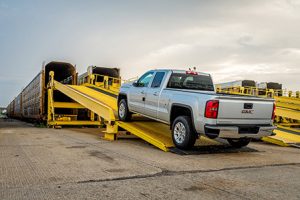 GM is bringing more logistics functions back in-house to regain the ability to engineer its own inbound, outbound and international flows, but outsourcing still plays a key role across the supply chain
GM is bringing more logistics functions back in-house to regain the ability to engineer its own inbound, outbound and international flows, but outsourcing still plays a key role across the supply chainRewriting history for outsourcing Taken as a whole, the new organisation brings GM closer to a sales and operation planning (S&OP) structure that aims to align management and operations with the same goals, using constant communication and technology to sync with consumers and suppliers. S&OP can be found in the supply chain organisations of a number of technology, e-commerce and consumer goods firms.
But if GM stops short of a full S&OP setup, it is partly because some of its objectives involve changes among sensitive operations that could risk the stability of production, if not handled carefully. Upgrading and rebuilding systems across plants and suppliers takes time and must be done correctly to avoid disruption.
Also notable among the changes is a significant push to bring back in-house some areas of logistics management that had been outsourced. “Going back 15-20 years, we outsourced a lot of logistics activity, and now we are slowly bringing it back in-house. This includes our capability to engineer the network, as well as entire systems for inbound, outbound and international flows,” says Bovenzi.
Such efforts are the latest swing of the pendulum in GM’s approach to managing logistics. In 2001, for example, it signed an agreement to outsource almost all of its global logistics management and contracting entirely to a joint-venture fourth party logistics provider (4PL), Vector SCM. Five years later, however, it brought most of that management back in-house in an effort to regain control and visibility of its supply chain.
"We will have visibility from the moment a part comes off the supplier’s assembly line, all the way through delivering a car to a dealer. That will allow us to have the right containers, the right packaging, the right mode of transportation, inventory levels and frequency of routes." - James Bovenzi, GM
But that ‘insourcing’ did not end or change a significant reliance on third parties for key areas of logistics management. In North America, the carmaker has used lead logistics providers (LLPs) to manage most of its inbound logistics network routing and engineering, transport mode selection and carrier management, and supplier follow-up. For example, Ryder is the LLP for GM’s US and Canadian plants and their inbound supply chains, while Penske does the same for plants in Mexico.
Global freight forwarders, meanwhile, have been responsible for engineering flows and consolidation across the carmaker’s huge flow of containers for material around the world.
Furthermore, a variety of outsourcing arrangements for logistics management, sourcing and IT systems have developed in other regions. In Europe, a partnership with France’s PSA led to a comprehensive 4PL contract with Gefco from 2013, covering inbound and outbound logistics management and operations across production and sales in the wider region. In China, GM’s web of joint ventures means that, like other OEMs there, logistics is often in the hands of local partners’ in-house logistics providers, such as the SAIC Group’s Anji Automotive and Anji-Ceva joint venture.
But now, at least in North America, GM wants to rebuild its management resources and expertise in areas that Bovenzi sees as important competencies. The carmaker is therefore hiring new staff, absorbing some from existing LLPs and training its teams. The insourcing is also being done in conjunction with the rollout of new IT systems across three core areas: engineering; sourcing; and visibility for every logistics transaction.
This in-house development and IT investment is part of a multi-year business transformation project that GM has dubbed GLIDE (Global Logistics Integrated Design and Execution). It also includes using business intelligence tools, improving freight visibility and forecasting, and automating communication and billing.
[sta_anchor id="3"]“GLIDE integrates the silos across our organisation. All the processes come together and break down barriers,” says Bovenzi.
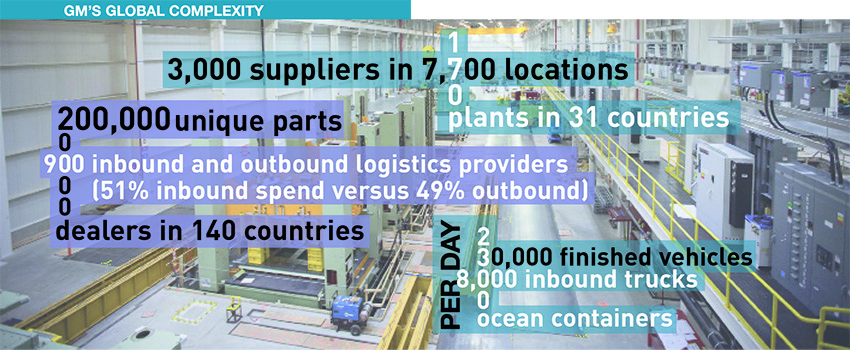 For example, in North America GM has already launched a logistics sourcing tool that combines route engineering and transport costs on a single platform. In early 2017, a system for sourcing and managing international inbound freight is set to come on-stream, as well as an inbound visibility system for North American domestic flows. Outbound vehicle logistics visibility is scheduled for 2018.
For example, in North America GM has already launched a logistics sourcing tool that combines route engineering and transport costs on a single platform. In early 2017, a system for sourcing and managing international inbound freight is set to come on-stream, as well as an inbound visibility system for North American domestic flows. Outbound vehicle logistics visibility is scheduled for 2018.
Such systems are supplemented with a suite of business intelligence tools that allow GM to model different scenarios based on plant and supplier locations, volumes and other constraints to produce optimal network design. “This has helped us to go from a very tactical execution to providing a more strategic input into major corporate decisions,” says Bovenzi.
Another important aspect of taking these tasks and systems back within logistics and demand/supply is to incorporate advanced planning for logistics into GM’s model development as early as possible, something in which the carmaker has made progress in recent years in areas ranging from packaging to planning line-side delivery. However, Bovenzi still sees more scope to incorporate viewpoints, data and cost factors across the company.
“We had our inbound network design outsourced, for example, with people working on it that were very capable,” he says. “However it was trunked up into so many pieces that nobody had total visibility. We were only optimising a subset of the enterprise.
“By bringing it in-house, we are better able to see the full picture and understand all the trade-offs.”
Bovenzi maintains that GM will not be insourcing all of this activity and that LLPs like Ryder and Penske will retain a large share of what they do in operational areas. The carmaker mainly wants more control over network design and sourcing.
[sta_anchor id="4"]“We are moving towards a hybrid model of outsourcing, as there are certain things that our LLPs are very good at and we wouldn’t want to take them away,” he says. “We still depend on much of our supply base and providers for innovation.”
The evolution of purchasingGM’s new supply chain and logistics organisation is in many ways more an evolution than a revolution; in fact, many of the changes are continuations of purchasing and logistics strategies that have taken place over the last decade or more.
On the material purchasing side, for example, GM had previously put a strong focus on price, leading to growth in ‘low-cost country sourcing’. In the 2000s, the carmaker sought out suppliers in sometimes far-flung locations with low labour costs to ship parts to global plants. Since then, however, especially since emerging from bankruptcy in 2009, the carmaker’s purchasing management has emphasised ‘total enterprise cost’, which aims to account for potential costs related to logistics, inventory and risks from specific material sourcing and production locations.
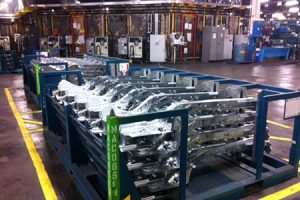 By further integrating logistics, supply chain and network engineering with order fulfilment and sales considerations, GM is better able to plan and design not only transport but also packaging requirements
By further integrating logistics, supply chain and network engineering with order fulfilment and sales considerations, GM is better able to plan and design not only transport but also packaging requirementsThe result has not been an end to global material flows; on the contrary, these have risen across shared and co-located global vehicle platforms. However, GM has used a combination of improved calculation tools and better planning between purchasing, manufacturing and logistics to make more informed decisions.
As Bovenzi puts it, the entrenched silos at ‘old GM’ might have led it to balk at increasing its material purchasing budget even if it meant a bigger reduction in logistics costs. “Today, in the new GM, we will gladly take the small hit in material costs to lower logistics and overall costs,” he says.
Much of this progress predates the demand/supply department. However, the reorganisation supports such a culture, including by measuring the impacts of sales and marketing objectives across the supply base. Likewise, the ability for GM to design and engineer its own logistics networks makes it more able to consider the cost and inventory impacts of material purchasing and production decisions. In this sense, GM can assess operational realities in its supply chain and make sure that the numbers produced by its modelling tools reflect ‘real life’.
“In better integrating our supply chain operations, business processes and communication are our first step, after which point IT systems can help to support us,” Bovenzi says.
“If an organisation looks to IT to find a solution to a mistake or problem for which they haven’t established the right business process or culture, it can cause more problems,” he adds. “That is why we have focused on establishing the right culture, process and communication first, and then support it with the appropriate hardware and software.”
Over past years at GM, total enterprise cost has developed from being a common sense approach to sourcing into a strategic instrument. In 2014, prior to its reorganisation in GPSC, GM set an objective of shaving nearly $1 billion from its logistics budget over several years. Strategies for the reduction included a number of enterprise-wide investments across key sites in North America, including localising stamping plants and extending rail lines, as well as bringing more suppliers closer to GM plants.
According to Bovenzi, GM is on pace to meet or exceed cost-reduction targets, which he credits largely to executive director of global logistics and containers Edgard Pezzo’s global logistics organisation and its efforts to reduce waste.
Bovenzi also points to improved communication across departments, including for supplier localisation both within North America and in other regions with high currency volatility, such as Asia and South America.
 GM’s cost-reduction targets are being met partly through a combination of logistics waste reduction and the use of an analysis tool that assesses supplier localisation suitability
GM’s cost-reduction targets are being met partly through a combination of logistics waste reduction and the use of an analysis tool that assesses supplier localisation suitabilityBovenzi, who led GM’s global localisation strategy before his current role, points to several efforts in this area. He uses the analogy of assessing ‘dirt’ versus ‘diamonds’ in material purchasing. The diamonds represent those parts that have a high value and are easy to transport, and can therefore be sourced and moved almost anywhere. Dirt, on the other hand, should be sourced locally. It is bulky, heavy and costly to move, even if it has a lower value itself.
Of course, not all parts fit easily into such categories, which is why GM’s purchasing and supply chain executives have refined a supplier footprint analytics tool that models inputs, including logistics and material costs, country competitiveness, investment, tooling and currency.
“We can use the tool to analyse where we might manufacture and localise models,” Bovenzi says. “If, for example, we are building a platform in four global locations, we can use the tool to determine whether we would localise tooling and suppliers in all four locations, or the two or three that would be best.”
[sta_anchor id="5"]According to Bovenzi, the tool helps to make sourcing more objective “and to build a culture where we can make a million decisions like this properly every day”.
Less risky businessSince realigning the supply chain organisation further, efforts to incorporate forecasting for sales and supply constraints have helped GM improve in other areas, including lowering the risk of supply disruption and reducing premium freight shipments. Several years ago, says Bovenzi, imbalances between demand and supply were among those identified as top threats to the company.
“I think it is an indirect compliment to our organisation that when we refreshed our risk outlook this year [2016], Alan Batey [the president of GM North America] said that it was under control and should come off the list,” says Bovenzi. “That doesn’t mean we don’t have issues, but there is a process in our team to handle it and we know what to do.”
Reducing this risk has been particularly critical, given some of the fast and perhaps unexpected shifts in the market that have required a response. For example, the growth of SUVs, trucks and crossovers in recent years has surpassed many market expectations, even as the decline of cars has been more extreme than anticipated.
 GM is looking to increase the efficiency of AGVs moving between delivery docks and point of use at its plants
GM is looking to increase the efficiency of AGVs moving between delivery docks and point of use at its plantsWithin the boundaries of its supplier and internal production capacity limits, Bovenzi says GM has been able to change production and respond to the market much quicker than before – “almost overnight”, in some instances.
“Again, much of it comes down to communication, both within our organisation and with suppliers, to see what could be and needed to be done,” he says.
[sta_anchor id="6"]Some changes, of course, such as installing new capacity or changing models, require investment and longer lead times, but Bovenzi suggests his team is better prepared to see what the carmaker may require over time as well, and help influence those decisions up- and downstream in the supply chain.
Global opportunities Rebuilding internal logistics resources, expertise and IT all takes time, and is part of the reason that GM is taking integration steps at its own pace, and not everywhere at once. Some projects have an international if not global focus, such as the intercontinental freight engineering system, while both the logistics and containerisation organisation and the supply chain group are global in scope and share strategies across regions. However, the deeper integration across demand/supply and the bulk of the insourcing focus have so far been North America-focused.
“We purposely said that we shouldn’t try to take on the world and stumble, but instead make changes properly as people are ready,” confirms Bovenzi.
However, there are already steps towards a more global approach and more integration is likely over the coming years. Bovenzi acknowledges that regional differences in GM’s organisations make ‘copy and paste’ impossible, but suggests the fundamentals of sharing demand and supply capacity forecasts can be applied elsewhere. He also points to global platforms that produce models and share parts over several regions, such as the ‘GEM’ platform, a small-car initiative that will be produced in North America, in China by GM’s joint ventures, and elsewhere.
“There, we will need to join capacity and demand planning because we will be sharing components and suppliers across regions,” he says. “In this case, we will let the business needs pull change in our organisation, rather than drumming up a process that we are going to impart elsewhere.”
 The emergence of electrification on a larger scale will present some new logistics challenges, particularly in lithium-ion battery handling
The emergence of electrification on a larger scale will present some new logistics challenges, particularly in lithium-ion battery handlingLessons can also flow both ways, as some regions have already taken a lead in aspects of this integration. Three years ago, for example, Opel/Vauxhall began to further connect its order and capacity management with its plants’ bill of material and logistics planning in Europe as part of implementing an ‘order slotting’ system that provides real-time updates to forecasts and production planning based on changes in demand or supplier constraints. The carmaker is now starting to apply aspects of this forward planning and schedule stability [sta_anchor id="7"]to its outbound logistics, for example, including a number of trials in planning carrier loads that could be interesting for the company more widely.
Packing in the changes Technology, particularly digital communication and analytics, is playing a key role in the management and decision-making of the new demand/supply organisation, but Bovenzi also points to the potential for efficiencies to be gained in operational logistics. GM has a number of programmes aimed at increasing its use of automated guided vehicles (AGVs), for example, and finding more efficient ways of getting from the delivery dock to the point of use on the line.
The technology in GM’s vehicles is also set to bring benefits. The carmaker’s OnStar platform, an on-board communication system, could have applications beyond consumer uses, for example, including in vehicle tracking and diagnostics for distribution and even in the aftermarket.
“I believe the business model will expand,” he says. “We’ve had rental car and fleet agencies ask us to look into that further, for example.”
GM and its logistics providers must also confront the challenges of vehicle electrification, a trend expected to grow strongly. The OEM will enter this segment more decisively with its soon-to-launch Bolt, a long-range, pure-electric vehicle that will be built at its plant in Orion Township, Michigan and also exported to other markets. Along with the technology advances, Bovenzi points to the special requirements for managing the vehicle in the supply chain, particularly regulations around its batteries.
“The lithium-ion batteries require special handling and packaging, with more limits on modes of transportation such as air,” he says. “If we have an issue with other parts, we can put it in the cargo hold of a commercial airliner. For these batteries, it has to be on a dedicated cargo plane – so it has a definite impact.”
"The auto industry is going to change more in the next five years than it has in the last 50." - Mary Barra, GM
Not all progress necessarily requires the latest technology, either. Bovenzi reveals that GM’s logistics team has been trialling the use of North America’s inland waterway systems to move freight for the first time in generations, besides for iron ore and steel, including via the Great Lakes and major rivers like the St Lawrence and Mississippi. In one case, GM has delivered overseas containers of freight as far inland as Cleveland, Ohio, and Bovenzi sees potential in the Detroit region itself. “We can all rally around such projects. For example, how can we develop Detroit into a port that can handle automotive requirements? We are now talking to city and development groups to gain traction.”
Still, new technology is set to define GM’s logistics and supply chain over the coming years. Bovenzi quotes GM’s chief executive, Mary Barra, in considering the company’s recent realignment: “The auto industry is going to change more in the next five years than it has in the last 50.”
Bovenzi points to online shopping, ride-sharing and autonomous cars and trucks as some of the areas that will impact logistics. New suppliers and sourcing clusters could form, as could new service requirements from customers and suppliers. So, too, could new opportunities to raise efficiency, from materials handling to autonomous trucks. And he wants his wider supply chain organisation, as well as suppliers and providers, to be ready.
“Many will see these developments as disruptors or threats, and certainly some will gain and lose more than others, but at GM we want to see the opportunities, not the threats,” he says. “As logistics professionals, we can be enablers of these changes.”



















